Sales Process Automation: Implementation Guidelines

In our world of booming technology, the most prominent businesses and organizations are enthusiastically streamlining their ventures with sales process automation.
As per Forbes, some businesses still have their sales reps investing about 50% of their valuable time in tasks that one can easily automate. Smart leaders are switching to automation, allowing their sales reps quality time to sell.
Sales process automation plays a crucial role in the sales process. It automates the tasks which are otherwise carried out by your sales staff.
A recent article states that more than 80% of business owners look forward to sales automation alternatives. Such business personnel realize how important it is to automate mundane sales management processes.
Sales automation helps close more leads and generate more revenue by freeing up time that your sales reps spend on routine tasks.
With robust sales automation tools like a visual sales pipeline, automated email campaigns, automated follow-up emails, assignment of leads, and automated segmentation, it is as easy as pie.
Here, I have tried to break down the sales automation process flow to get you started automating your business today!
What is sales process automation?
Sales process automation refers to the use of technology and software to automate various tasks and stages within the sales process.
This approach aims to improve efficiency, reduce manual effort, enhance accuracy, and enable your sales teams to focus on high-value activities. These activities can include building relationships and closing deals.
Sales process automation involves implementing tools, automated sales workflows, and systems that facilitate the management of leads, prospects, and customers from initial contact to final conversion.
How does sales process automation work?
Automation of sales processes via pre-built applications helps you close deals faster. The sales process automation aids your sales team in managing the sales pipeline in no time.
Various organizations utilize sales automation to develop sales funnels. These sales funnels effortlessly map out the journey of each prospect from the minute they are identified to the moment they become a buyer.
The sales funnel incorporates multiple activities like the following:
- Prospecting - Identification of relevant prospects.
- Lead generation - Finding contacts of prospective clients manually. Or automating your lead generation process.
- Follow up with generated leads.
- Lead nurturing - Moving the qualified leads towards the sales process via lead nurturing.
- Conversion of leads into opportunities.
- Sealing the deal.
The sales automation process comprises seven steps. Let us understand them in-depth below:
Automated guidance
With automated guidance, your sales team receives notes and reminders via the sales automation software.
Having regular reminders helps keep your sales reps on track and prevents them from missing working on important prospective clients who have high chances of converting into paying customers.
Lead management automation
Sales process automation enables the conversion of potential prospects into customers. With lead management automation, your representatives can work on creating filters and rules that allow them to curate a list of more potential leads.
Based on lead behavior and characteristics, like click-through rates, email opens, and social searches, the sales automation software helps you list down the potential clients. It segments your leads and classifies them into buckets or lists for you to work on.
Communication automation
Communication automation is an integral part of the sales automation process flow. It incorporates tasks like email automation, voicemail automation, personal email sequencing, and easy appointment scheduling.
Automated voicemails
Automated voicemails allow your sales staff to pre-record voice messages at their convenient time. These recorded messages are sent to customers when they do not answer a call.
This relieves your sales rep from thinking of different responses on the spot every time their call reaches a customer's voicemail.
Scheduling in-built appointments
It allows quick scheduling of meetings based on the availability of both parties. Your sales reps can schedule meetings conveniently in no time.
The sales automation software does the tracking with no requirement of making manual notes. In addition, both parties would also receive automated reminders for the meeting.
Personalized email sequencing
Having personalized drip campaigns for sales engagement would keep your customers informed about new updates on your products or services. They would receive informative emails now and then to keep up with the regular updates.
Sales email automation
Sales email automation helps automate tasks like unsubscribing an inactive email address from the list of emails. This step helps in saving time, facilitating in reducing spam complaints and bounce rates.
Automated data entry
Data entry is known for time consumption. It is incredibly time-consuming and tedious. In addition, it is an unavoidable task. The good part here is that the data entry task is a piece of cake with the automation process.
Sales automation enables auto-filling of data like contact details of customers and product details. Automation software streamlines the process and saves your sales reps’ time in abundance.
Automated research
Automated research can work wonders while seeking information on your potential customers and prospects. It goes beyond the human ability of your sales team to shake down social media platforms to increase sales and the web to extract information about potential prospects.
It then utilizes this information to curate updated lead profiles, identify hot leads, and score leads on their winning probability.
Such automated research helps your sales reps save time while still having the latest information about their contacts and prospective customers.
All of the extracted data is stored in a centralized repository, so it is easily accessible by every member of your sales team.
Automated activity logging
It can get confusing and chaotic if one of your sales reps is unaware of the proceedings of a colleague. This can include phone calls with customers, sales emails, or in-person visits.
So, it is necessary to add all these details in real time, such that your sales team knows how far another colleague has gotten with any potential client. Activity logging automation does it all for you, saving you a lot of time and reducing costly mistakes.
Automated record creation
Whenever your sales team receives newsletters or business cards, they can let the automation software create new profiles and records for future use.
Once the process of creating records is automated, your sales staff can have another tedious and time-consuming task off their to-do list.
Stages of sales automation
You might be aware of the meaning of sales process automation and all of its excellent offerings, but you may not be aware of how to go about the process. To help you understand better, I will walk you through the stages of a sales automation process.
Awareness
Your potential clients might know about your business online via social media platforms, paid advertisements, or a written post. This is a scenario where the client knows a little about your business but lacks in-depth knowledge.
Now is the stage when you create awareness. You can pitch in some undeniable offers using multi-channel engagement to boost sales via SMS or email for a limited period.
Extending an offer would allow engagement with your potential lead and evoke their interest in your product or service.
Interest
The interest stage is about building and capturing the lead's interest. You can automate several tasks with your leads.
For example, if the lead shows interest in your offerings, you can jump to the next step. At this stage, the lead must have had some interaction with a member of your sales team. The client must have requested a cost quotation or have subscribed to email newsletters.
Now that the potential lead is showing interest in your service or product, you can prepare to educate your client with in-depth details about why they would require your services.
This is where the process of automation steps in. You can automate a list of welcome emails to send out to clients. You can also set up reminders for your sales reps to reach out to schedule a meeting with clients via click-through emails.
Decision
The decision stage is the third phase of the process. Here, you depend on automation to keep close contact with your leads. You share vital details about your offerings and shoot out information like product descriptions, invoice details, and pricing plans.
Sales automation tools help you to automate the events of storing, updating, and sharing essential documents with your potential customers in no time with minimum effort.
Action
The final step is to convert to your prospect, collect payments, and help your new client get started.
This step can be time-consuming and eat up a lot of your manly hours. Such intense time spent on the final step can drag your sales work to slow down.
By implementing sales process automation, you can greatly cut down on the time and resources spent on this end stage. For example, you can automate tasks like sending useful guides to assist your customers in getting up to speed by themselves.
The automation software would also inform you of the exact details of payments, deals, and delivery products. You can deploy an automated invoicing system that would help reduce administrative efforts.
What are the benefits of sales process automation?
“It is easier to scale a company with a broken process being well executed, then it is to scale a company that has no process and relies on artistry.” – Jacco van der Kooij
Sales process automation offers you numerous benefits that can enhance the effectiveness of your sales operations. Here are some key advantages:
Improved efficiency
Automation eliminates manual, repetitive tasks, allowing your sales team to focus on high-value activities like building relationships. This leads to a more streamlined and simplified sales process.
Consistency
Automated workflows ensure that every lead and prospect is treated consistently, following the same standardized sales process. This consistency helps maintain your brand's image and customer experience.
Enhanced lead nurturing
Lead nurturing tools enable personalized and timely communication with your leads. This nurturing process keeps your leads engaged throughout their buyer's journey, increasing the likelihood of conversion.
Reduced errors
Manual data entry is prone to errors, but automation minimizes these mistakes, leading to accurate and reliable customer information.
Better lead management
Automation systems organize leads, segment them based on criteria, and prioritize them using lead scoring. This helps your sales teams focus their efforts on leads with the highest potential.
Want to automate and streamline your selling process?
With Zixflow, you can make your sales process more efficient and boost your revenue
Get in TouchHow to implement sales process automation?
To learn the implementation of automation, you must learn about each step in depth. For instance, you can appoint a robot to run through demos, but you can use email templates to schedule them.
Such tools help your sales rep to create presentations and proposals. Below are some steps to note while effectively trying to implement sales automation. Let us dive in!
Define your goal
To begin something new without a definite goal is not a great strategy. You can approach the process with a deliberate strategy with a defined goal.
Before you consider automating your sales process, ask yourself the following questions:
- Why does your business need automation?
- Are your business constantly slipping opportunities?
- Are your sales reps overwhelmed by administrative tasks?
- Do you desire to keep track more efficiently?
Whatever the answer, the conclusion sticks to the fact that you require automation. It would help if you looked at some case studies across your sales funnel and prioritized the lacking spaces.
Listed below are some tasks where you can implement marketing and sales automation tools:
- Lead generation and prospecting
- Updating customer data
- Lead scoring and qualification
- Segmenting your prospective customers
- Scheduling demos and meetings
- Creating proposals and sending them to your leads
- Communicating timelines, emails, and reminders
- Performance and deal reporting (this is useful for your sales team managers)
- Tracking orders and sales cycle - cold calls, order status, follow-ups, and reports
Use a sales automation platform like Zixflow
A sales automation platform is one of the essential digital tools to scale your sales. The right sales automation software will help you greatly in achieving your goals.
The automation platform you choose must be robust and provide you with capabilities to handle every aspect of the sales process.
Zixflow is one such platform that comes with powerful automation tools to keep your sales process on autopilot. To start, it enables you to create sales cadences to completely automate your follow-ups or outreach messaging.
You can add various stages while developing your outbound sales cadence consisting of multiple channels to reach out to your potential customers. These include SMS, email, or WhatsApp messages.
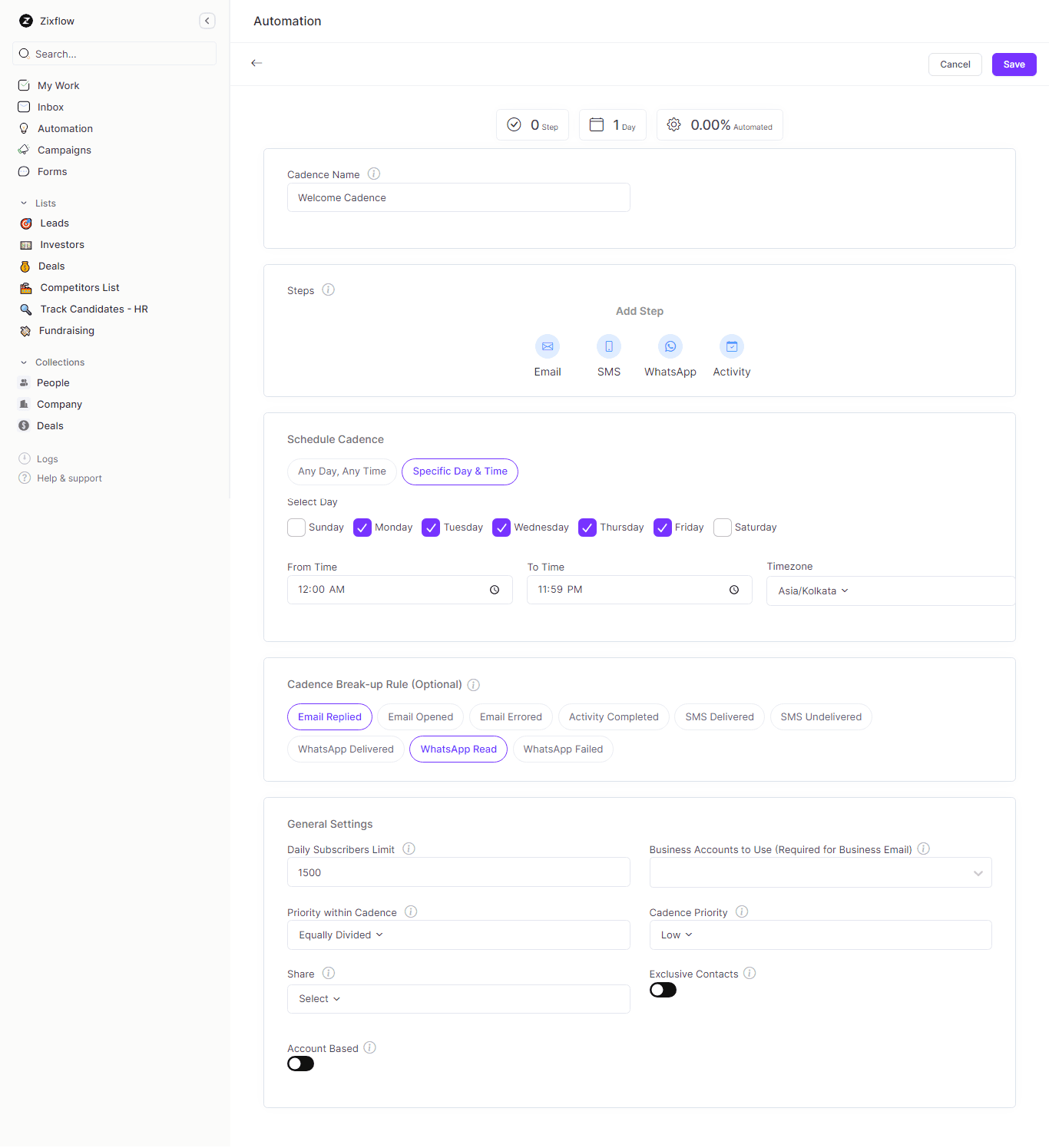
On top of that, you can create automated workflows that can be triggered when particular conditions are met. You can also add specific actions that the application has to take once the predetermined conditions are fulfilled.
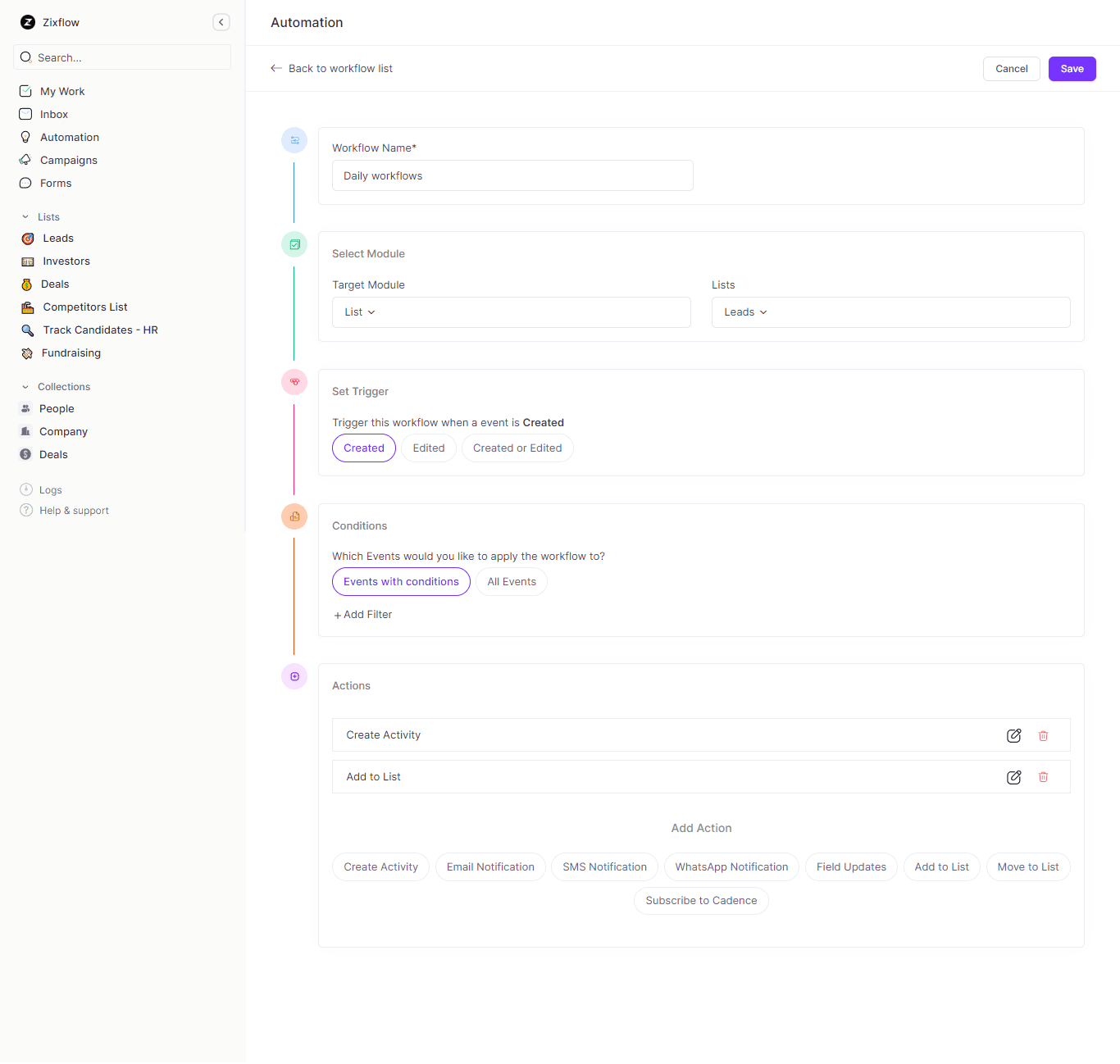
Furthermore, it comes with a sales CRM that will house all your customer data and will become the centralized center for the sales process. Every detail of your customers would be collectively present in the CRM.
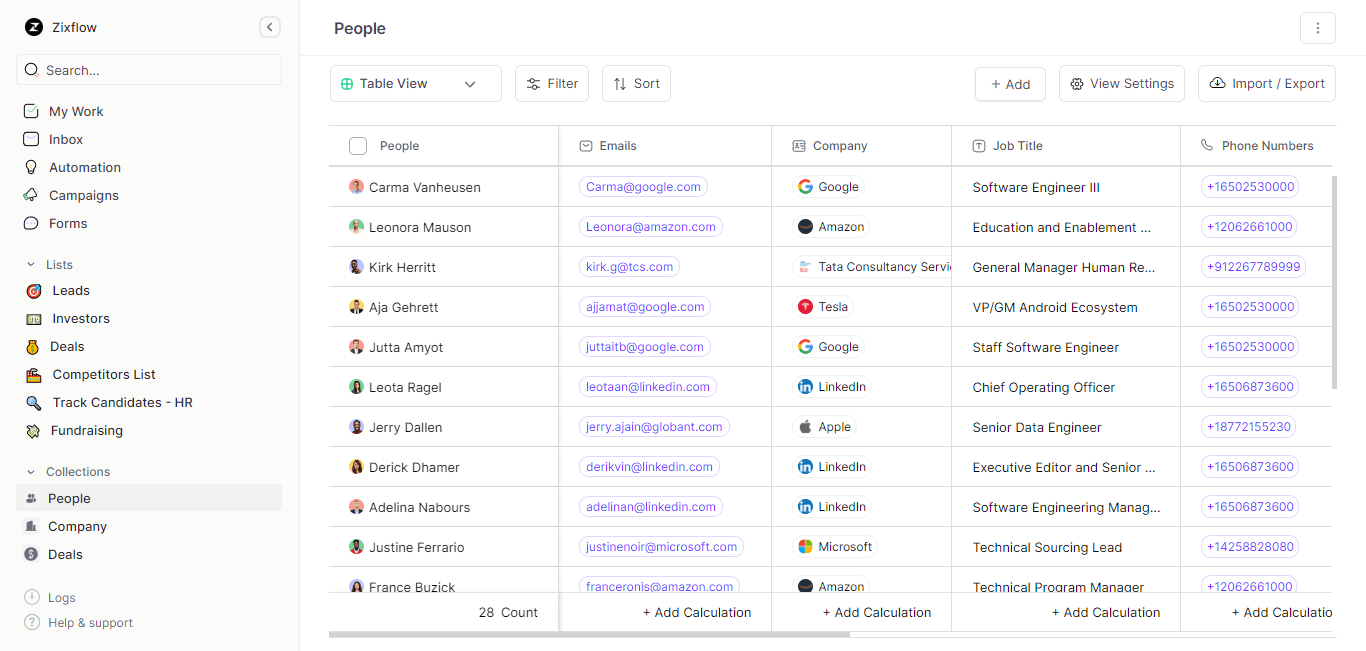
Begin small with AI
If implemented correctly, generative AI in the sales process can be mighty. If you wish to be on a journey with artificial intelligence, you must think about features like AI chatbots.
AI chatbots help you automate the top of the sales funnel, also known as lead generation. Chatbots can proactively reach out to your website visitors, gather customer information, trigger qualification sequencing, and help your sales reps with lead qualification.
Look into templates
Are your sales reps sending out standard emails, or are they spending time creating newer ones every single time? This is a counterproductive approach and can have inconsistency in the tone of voice of your company.
Some automation tools help you with built-in templates for your use. You can also create your template and upload it to the software. For instance, you can curate a sequence of your cold emails and attach them.
Or you can create your cold email sequences and add them to your sales system where you can send them automatically and track results.
Once again, Zixflow with its AI Wizard, lets you automate this step by generating suitable email content with a click of a button.
All you have to do is type in the information in the required fields and the system will automatically create an email template you can use right away or save for the future.
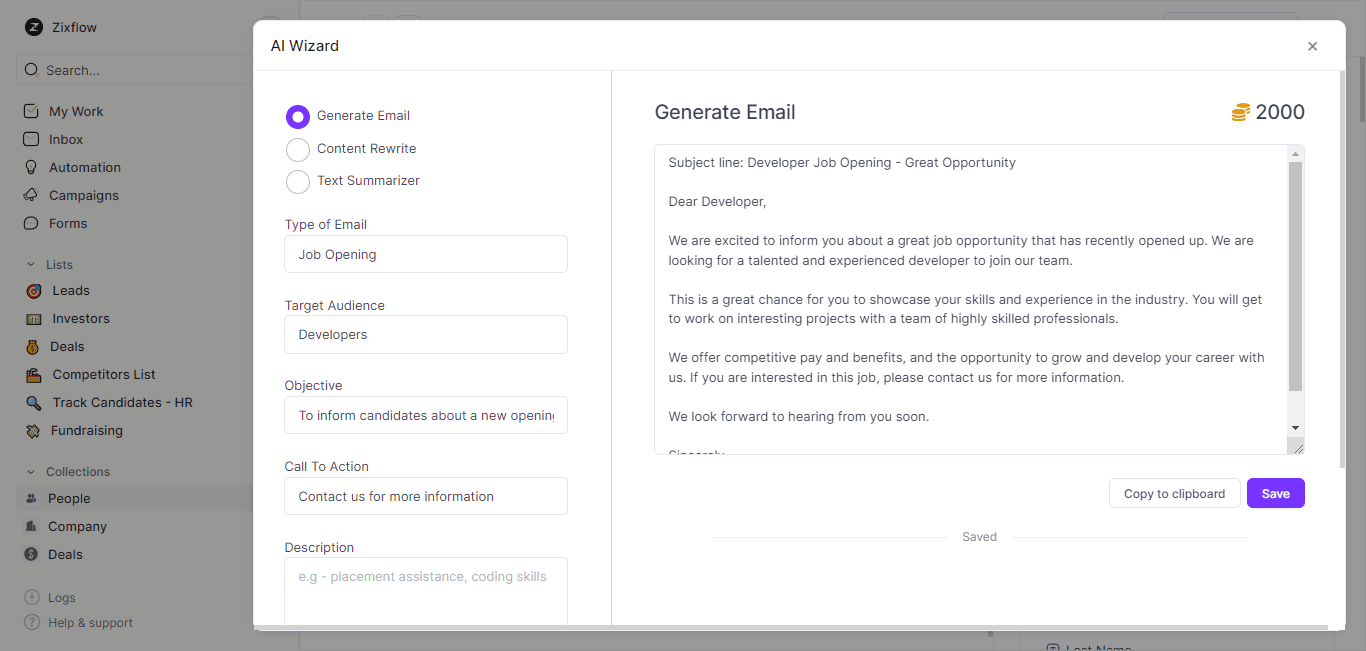
Integrate workflows and data
Centralizing and processing information is crucial for a successful business.
Having every data collected in one place helps in the completeness and accuracy of data, saving you ample time while updating information. Once updated, the information can go live across every system.
This is why your automation platform is required to integrate with other tools. For instance, your sales chatbot should seamlessly integrate with your CRM and your scheduling tool with your outreach management tool.
For this reason, Zixflow offers you a lot of integration options so you can easily integrate it with your favorite apps to maintain efficiency and effectiveness.
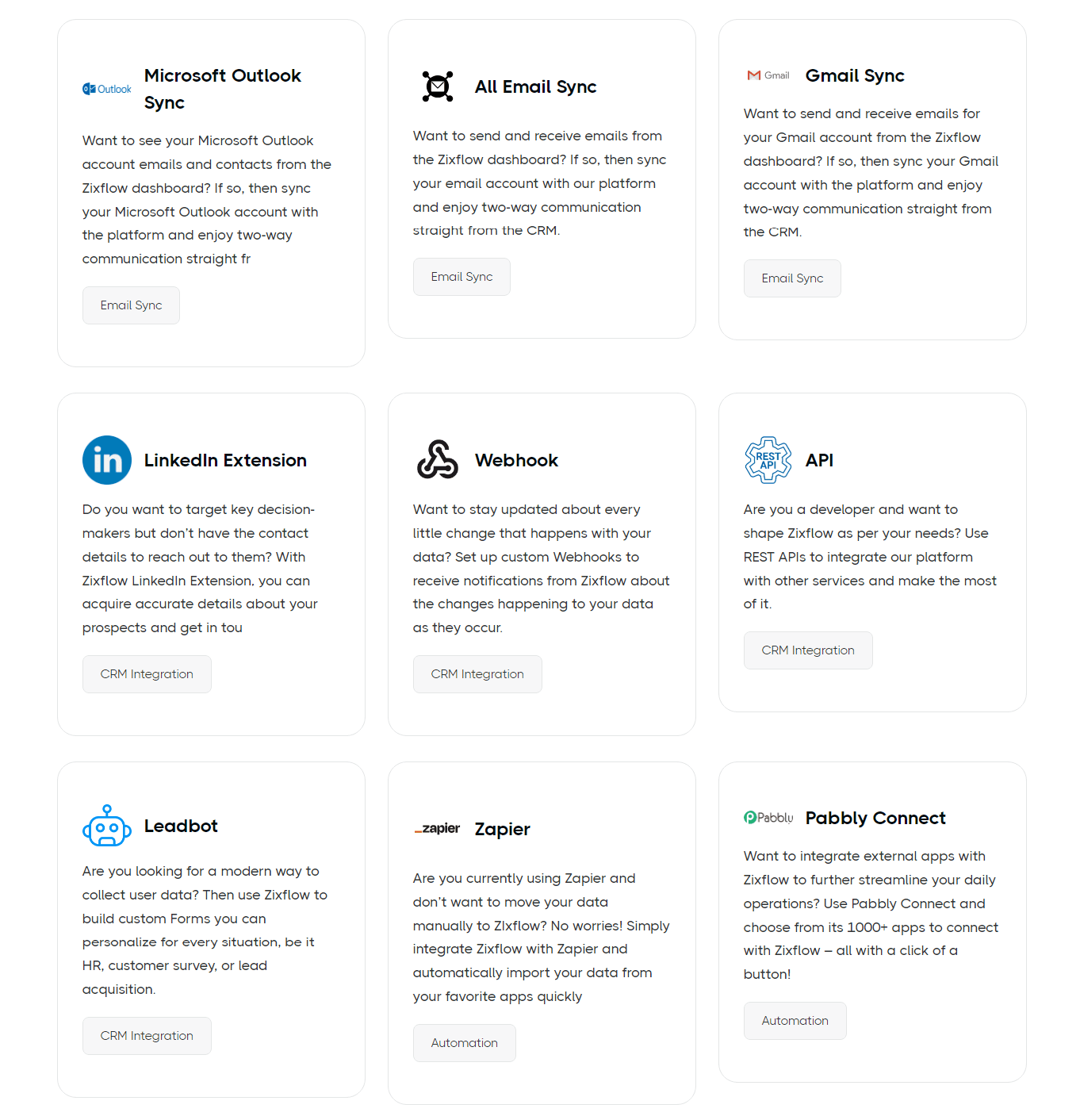
Train your team
Management changes play a vital role in the implementation of sales automation. The daily work routine of your sales team would change as a part of their workload is automated.
For that reason, they would require training to use the new systems effectively. Sales enablement is a continuous process of providing your sales staff with the necessary training, tools, and content to ensure high sales performance.
You can aim at workshops, open communications, videos, and documentation to help your sales team take advantage of automation.
Frequently asked questions about sales process automation
Here are some of the common questions about sales process automation:
What tasks can be automated in the sales process?
You can automate lead data entry, sending follow-up emails, scheduling meetings, assigning leads to specific sales representatives, lead scoring, updating CRM records, and generating reports.
Will sales process automation replace human interaction in sales?
No, automation complements human interaction.
While routine tasks can be automated, the human touch is crucial for building relationships, understanding customer needs, and addressing unique challenges. Automation frees up time for you to focus on these interactions.
Is sales process automation suitable for all types of businesses?
Yes, sales process automation can benefit businesses of all sizes and industries. The extent of automation may vary based on the complexity of your sales process and the specific needs of your business.
What tools are commonly used for sales process automation?
Customer Relationship Management (CRM) systems, marketing automation platforms, email marketing software, workflow automation tools, and artificial intelligence (AI) solutions are commonly used for sales process automation.
If you're looking for sales automation software, then you can use Zixflow, an all-in-one salesOS that offers automation, management, and outreach functionalities.
Automate your sales process to streamline your sales operations and increase revenue
Sales automation allows you to acquire a competitive advantage over competitors in your field. Map out your strategy, experiment, and work towards enhancing your efficiency.
Now, how to start intelligent process automation for sales and support? Automation can be a piece of cake with the right companion by your side.
Zixflow is the answer to your manual business operations that require a push of efficiency in the name of automation.
So, why wait? Book your free demo today and learn more about advanced automation with the best in the industry.
